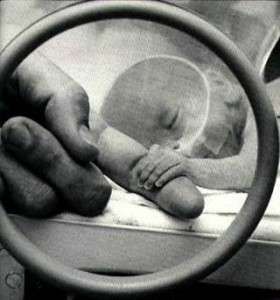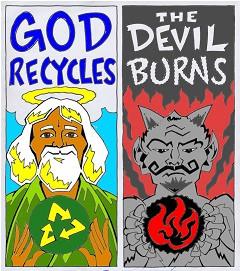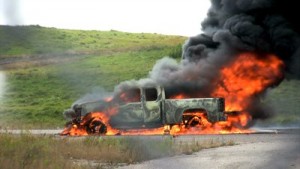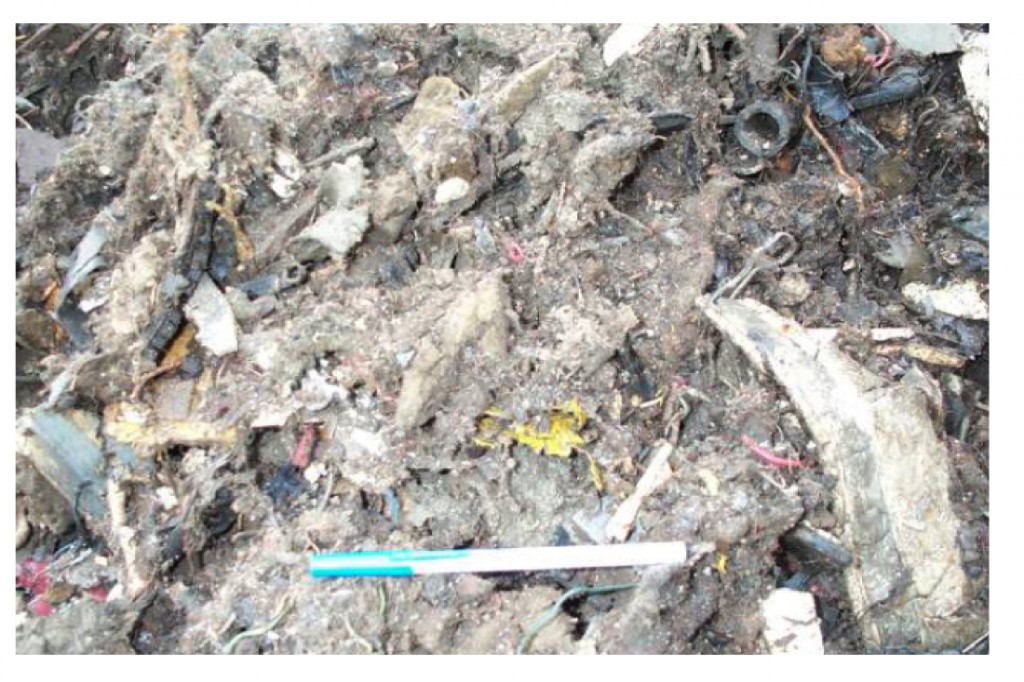Auto Shredder Residue
Study: Low Levels Of Incinerator Pollution Linked to Premature Births
 A new study being published in the November issue of Epidemiology concludes that even low levels of pollution from solid waste incinerators causes an increase in premature births downwind.
A new study being published in the November issue of Epidemiology concludes that even low levels of pollution from solid waste incinerators causes an increase in premature births downwind.
Italian researchers examined over 21,000 births to women living within four kilometers of one of eight solid waste incinerators operating in the Emilia-Romagna region.
"Each newborn was georeferenced and characterized by a specific level of exposure to incinerator emissions, categorized in quintiles of PM10, and other sources of pollution (NOx quartiles), evaluated by means of ADMS-Urban system dispersion models. We ran logistic regression models for each outcome, adjusting for exposure to other pollution sources and maternal covariates.
Preterm delivery increased with increasing exposure….A similar trend was observed for very preterm babies. Several sensitivity analyses did not alter these results. Maternal exposure to incinerator emissions, even at very low levels, was associated with preterm delivery"
Now, you can reassure yourself that we have no single-purpose solid waste incinerators around these parts the way they do on he East Coast or Midwest, so we don't have to worry about this kind of threat. But that's not entirely accurate.
We do have solid waste incinerators in North Texas, they're just called cement kilns. And we have more incinerator capacity than anyone else in the country when it comes to cement kilns.
And, as it turns out, these cement kilns are expanding their lists of available "fuel" to include solid wastes, as well as coal – medical, municipal, and "hard to burn" plastics, as well as car parts, shingles and carpet remains. It's all part of the new wonderful world of commercial garbage burning. If the kilns happen to make some money in the process of turning themselves into under-regulated incinerators, well, all the better for their operators.
For example, and try not to throw up, in the Philippines, the local cement plant is marketing the burning of "Holcimables." What are "Holcimables" you ask? They're "plastics – styrofoam, sando bags, cellophanes and foil packs – textile and rubber." Yes, the same company that operates a cement kiln in North Texas is burning styrofoam in the name of environmental-friendliness in the Philippines. You can bet the Italian incinerators included in this new study were burning some of the same kinds of wastes with the same ingredients.
Burning stuff is bad, whether it's in an incinerator or a cement kiln. And industry is making it very hard to tell the difference.
“March of the Incinerators” is Killing Recycling in Britain
 For the first time in 30 years recycling rates in the UK are going down and a influx of incineration capacity is being blamed.
For the first time in 30 years recycling rates in the UK are going down and a influx of incineration capacity is being blamed.
New European Union directives favoring waste burning over recycling are now spreading throughout Great Britain and having a big impact. Landfill disposal has gone down by almost 50% in just over a decade. Meanwhile there are now 39 incineration plants in the UK that have either been built are under construction or are at the planning stage – so many that there are now concerns about overcapacity. Moreover, every time an incinerator is chosen over other options, it institutionalizes the economics of incineration.
Experts said the use of incinerators had consequences for recycling as local authorities were forced to divert waste to feed the plants. "The choice to invest in thermal treatment can hold back recycling efforts," Adam Baddeley, principal consultant at Eunomia, said. "At one level, the money invested in such plant simply isn't available to put into building recycling plants or collection infrastructure. And once you've built an incinerator or gasifier, there's a strong incentive to keep it fed with waste, even if that means keeping on collecting as 'black bag' rubbish, material that would be economically practicable to collect separately for recycling."
Because Texas is still home to relatively cheap and abundant land, it hasn't seen the wave of incinerators that swallowed up the budgets of East Coast and Midwestern towns throughout the 1980's and 90's. But that may be about to change with increased urbanization, the desire of cities to profit from their garbage somehow, and new regs that are written to encourage incineration of "biofuels" that can include waste. Some local observers think it's only a mater of time before a large garbage incinerator is proposed for the Dallas area.
But why wait when you've got three large cement plants down the road?
Hazardous waste was burned in two out of the three Midlothian cement plants for decades and now all three are burning different kinds of solid wastes, including tires, car parts, and "non-recyclable" plastics. They're the front line in the March of Incineration in North Texas.
Your’re Downwind of Lots of Burning Trucks
 A funny thing happened to Dallas Morning News automobile columnist Terry Box while he was out test driving a new Dodge pick-up truck – it self-immolated and burned to ashes on the side of the road. As he writes about it, his experience is both funny and terrifying. But something he noted in how cars and trucks are made these days caught our eye:
A funny thing happened to Dallas Morning News automobile columnist Terry Box while he was out test driving a new Dodge pick-up truck – it self-immolated and burned to ashes on the side of the road. As he writes about it, his experience is both funny and terrifying. But something he noted in how cars and trucks are made these days caught our eye:
"Open the hood of your late-model car or truck, and you’ll see a half-acre of plastic — actual engine pieces like valve covers, caps and containers for various liquids.
Thirty years ago, most of the pieces under the hood were metal and resistant to fire.
A fire in a modern vehicle burns fast and furiously. What’s intact for the moment can be gone or enveloped in toxic smoke in a matter of seconds."
Yep. When we've described the lovely new cement additive called ASR – Auto Shredder Residue – we've often talked about all the vinyl seats, dashboard and switches that get stipped out of a car and shredded, then thrown into a cement kiln. We really haven't talked about all the plastic in the engine compartment that would also be included in this new "fuel" that TXI has already been permitted to burn at its Midlothian cement plant.
As more and more of every car is made of "soft materials" – that is, not metal – more and more of it becomes fodder for cement kilns. This is material that could be recycled but isn't, and as long as it's cheaper just to burn it, there won't be amrket for recycling it.
Here's the thing, burning plastic creates bad kinds of pollution, including the creation of Dioxin, one of the most potent posions ever discovered by science. The same "toxic smoke" Terry Box saw pouring off of his burning Ram pick-up is created when you throw the same plastic parts into a cement kiln. The cement industry would like you to think that all of that is taken care of by the polluton control measures installed at the kilns, but it's not. There's no real time Dioxin montoring, much less any kind of monitoring for the host of other exotic fumes coming off burning plastic of various kinds. They barely even know what or how to test for such pollutants, but that doesn't keep the cement industry from marketing its kilns as "Long, Hot, and Good for America"™
If you're an old-timer, you might remember an earlier episode or two that occurred when the cement industry, including TXI, assured everyone that it could burn hazardous waste and make it completely disappear into water vapor. Remind us, how did that turn out?
“Statistically Significant Increase” in Risk of Dying from Cancer in Towns Near Incinerators
 You know that argument you sometimes hear about how those ecologically-minded Europeans are burning everything in incinerators and cement plants, so it must be OK to do it here? Maybe not so much.
You know that argument you sometimes hear about how those ecologically-minded Europeans are burning everything in incinerators and cement plants, so it must be OK to do it here? Maybe not so much.
In one of the most ambitious and far-ranging efforts of its kind ever attempted, the newly-published results of a 10-year study from Spain's national Center for Epidemiology looked for 33 different kinds of cancer in dozens of Spanish communities that hosted "waste incinerators and installations for the recovery or disposal of hazardous waste." They found "a significant higher risk from all cancers in towns near these industries."
Cancer impacts were greater around waste incinerators and scrap metal operations – you know like the three giant Midlothian cement plants upwind of DFW that are burning larger and larger amounts of industrial wastes and the steel mill across the street from them melting scrap cars.
Researchers used standard computer modeling to estimate what cancer rates should be in the host communities and then compared them to what they actually were.
"Excess cancer mortality was detected in the total population residing in the vicinity of these installations as a whole and, principally, in the vicinity of incinerators and scrap metal/end-of-life vehicle handling facilities, in particular. Special mention should be made of the results for tumors of the pleura, stomach, liver, kidney, ovary, lung, leukemia, colon–rectum, and bladder in the vicinity of all such installations. Our results support the hypothesis of a statistically significant increase in the risk of dying from cancer in towns near incinerators and installations for the recovery or disposal of hazardous waste."
There has never been any kind of systematic study of cancer rates around and downwind of the Midlothian cement plants. From the Texas birth defect registry we know that certain reproductive organ birth defects that are associated with pollutants known to have been released from the plants are higher than the state average in Ellis County.
This study, as well as the recent warnings of the federal Agency for Toxic Substances and Disease Registry about the public health dangers of the pollution coming from the Midlothian cement plants arrives at a time when the plants are gearing up to add plastics, car interiors, and other kinds of garbage to their lists of "fuels" that will be burned. After losing the fight to be able to burn hazardous wastes willy-nilly in cement plants, the industry is turning to industrial and municipal garbage that can produce many of the same worrisome kinds of pollution. This is what makes the EPA rules governing the emissions of the nation's cement plants – rules that are still in play – so very important.
German Cement Plants Now Mostly Waste Burners
 The cement industry calls it "alternative fuel" or "co-generation," but it's really just waste burning. This was true during the 1980's and 90's when the cement industry began converting kilns to large hazardous waste incinerators, and it's true now that the industry is trying to turn kilns into giant garbage incinerators. In one permit request after another across the country, cement plants are adding not just used tires and oil, but plastics wastes, automobile interiors and anything else they can get in bulk to the list of "fuels" they can burn. Locally, TXI's 2011 "permit amendment" allows the Midlothian kiln to burn a long lists of industrial wastes. To see where this leads, look no further than Germany, where fully 61% of all fuel consumed in that nation's cement kilns in 2011 was provided by plastics, used tires, and used oils. It's worth noting that European emissions requirements are usually stricter than EPA's, but the figure is still alarming since it was only about 30% in 2000.
The cement industry calls it "alternative fuel" or "co-generation," but it's really just waste burning. This was true during the 1980's and 90's when the cement industry began converting kilns to large hazardous waste incinerators, and it's true now that the industry is trying to turn kilns into giant garbage incinerators. In one permit request after another across the country, cement plants are adding not just used tires and oil, but plastics wastes, automobile interiors and anything else they can get in bulk to the list of "fuels" they can burn. Locally, TXI's 2011 "permit amendment" allows the Midlothian kiln to burn a long lists of industrial wastes. To see where this leads, look no further than Germany, where fully 61% of all fuel consumed in that nation's cement kilns in 2011 was provided by plastics, used tires, and used oils. It's worth noting that European emissions requirements are usually stricter than EPA's, but the figure is still alarming since it was only about 30% in 2000.
TCEQ’s War on Public Hearings
 You already know how much the current Perry-fueled Texas Commission on Environmental Quality has stripped the right of citizens to contest permits being issued like candy to polluters in Austin. In Texas, you can decide to change your entire fuel regimen, from coal to coal and tires, and plastics, and car interiors, as the TXI cement plant in Midlothian recently did, and not face any public questioning at all. Or say you want to tear down your old plant and put up a new one. You don’t need any public comment or hearing for that either, as Ash Grove found out when it applied for its “permit amendment” to rebuild its Midlothian cement plant. There has been a very premeditated and methodical campaign to make it impossible for any member of the public to interfere in the least bit with the right of the polluter to do any damn thing they want. Today, TCEQ is voting to go after other state agencies’ ability to interfere as well, making it impossible, for example, for the Texas Parks and Wildlife Department to intervene in a case where the state parks might be impacted by a polluter. The proposed rules would “have a significant impact on the TPWD’s ability to carry out its statutory and regulatory obligations and its ability to protect the shared public resources of the State of Texas that are under TPWD’s jurisdiction,” the agency wrote TCEQ in protest. It’s just another effort to destroy the checks and balances of a regulatory system that was already gamed toward industry in the first place. By the time this Governor leaves office, it may well be criminal offense to even ask for a public hearing.
You already know how much the current Perry-fueled Texas Commission on Environmental Quality has stripped the right of citizens to contest permits being issued like candy to polluters in Austin. In Texas, you can decide to change your entire fuel regimen, from coal to coal and tires, and plastics, and car interiors, as the TXI cement plant in Midlothian recently did, and not face any public questioning at all. Or say you want to tear down your old plant and put up a new one. You don’t need any public comment or hearing for that either, as Ash Grove found out when it applied for its “permit amendment” to rebuild its Midlothian cement plant. There has been a very premeditated and methodical campaign to make it impossible for any member of the public to interfere in the least bit with the right of the polluter to do any damn thing they want. Today, TCEQ is voting to go after other state agencies’ ability to interfere as well, making it impossible, for example, for the Texas Parks and Wildlife Department to intervene in a case where the state parks might be impacted by a polluter. The proposed rules would “have a significant impact on the TPWD’s ability to carry out its statutory and regulatory obligations and its ability to protect the shared public resources of the State of Texas that are under TPWD’s jurisdiction,” the agency wrote TCEQ in protest. It’s just another effort to destroy the checks and balances of a regulatory system that was already gamed toward industry in the first place. By the time this Governor leaves office, it may well be criminal offense to even ask for a public hearing.
First they Come for the Peanut Shells
Here's a story from Florida about the Brooksville Cemex cement plant's new permit that displays the quintessential spin from the cement industry about their transformation into garbage burners. 1)The headline uses the preferred industry term of "alternative fuels" instead of garbage. 2) It leads with all the feel-good fuzzy bio-garbage like peanut shells and wood chips. Only further down do they let you see the rest of the list – "including plastics, carpet, roofing materials and wood treated with creosote. Included, too, are so-called engineered fuels such as cleanup debris from natural disasters, processed municipal solid waste, dried and sanitized sewage bio-solids, noninfectious hospital materials, expired pharmaceuticals and confiscated narcotics." 3) It makes sure you know that this new garbage burning will shrink the plant’s carbon footprint and lower emissions of toxic chemicals like Mercury – but the plant will not be amending its operating permit to reflect those proposed decreases. 4) for all the talk of "alternative fuels," the plant is mainly still burning coal and tires, both of which it's been burning for a long time. The largest expense of running a cement plant is fuel costs. The industry is always finding a way to cut those costs. In the 1980's and 90's it tried turning cement kilns into hazardous waste incinerators by getting paid by polluters to burn their crap for less money than the pros. That met with quite a bit of public resistance and new regulations that made it harder to keep doing that. So now the industry is pivoting toward a laundry list of "non-hazardous" wastes – municipal garbage, sewage, medical waste, plastics, car interiors – garbage. Except that anyone who's ever studied the the history of American garbage incineration – and there's quite a history – knows there's nothing non-hazardous about the practice. Just because a waste isn't classified by EPA as a "hazardous" waste coming in the front door doesn't mean it doesn't emit hazardous air pollution when it's burned or carted off as ash out the back door. And even thought there's a lot of boasting about emission decreases, the industry isn't backing up that talk with real cuts in their permits. Places like Midlothian, home of three huge cement plants, and a concentration of cement manufacturing unmatched anywhere else in the US, are looked upon as nothing but large "landfills in the sky" to both waste producers and the cement plant operators themselves. TXI's Midlothian plant, directly south and upwind of DFW, just received a new permit "amendment" last June that allows them to burn the same kind of long list of garbage as the Florida kiln. They got this without any public notice or hearing or anything. None required as long as TXI promises, cross their heart, that the emissions won't increase above what they are now. And if they do? We won't even be able to know for sure until a test burn that will occur after they start burning garbage – they can wait up to a year to do the testing. This is why public participation is an over-arching issue in Texas now.Without it, there are no checks and balances. Only more experiments taking place in your lungs.
Toxic in a California Landfill = Safe in Your Texas Lungs
Via the NYT, we again revisit California’scrackdown on auto shredders and the toxic waste they generate that’s creating headaches for regulators. Auto shredders strip a vehicles of all of its non-steel, non-frame parts, send the frame off for scrap metal, and grind everything else into bits and pieces containing chemicals from Vinyl Chloride to Mercury to Lead to Asbestos to PCBs, depending on the age and model. It’s full of sharp metal, wires, and hard plastic, but for some reason, the industry nickname for this waste is a very cuddly “fluff.” When they cover this fluff with a “special coating” of cement-like material and bury it in landfills, it tends to leech out all of those toxic ingredients and cause problems. So why do you care? Because dear reader, what California thinks is too toxic to be landfilled, Texas is allowing into your lungs via TXI’s Midlothian cement plant, where the TCEQ just gave a permit to burn this very same kind of auto “fluff.” It was part of TXI’s “Landfill in the Sky” permit that Downwinders tried to modify or deny, except that the state agreed with the company that there should be no public notice, comment, or hearing on the matter. TXI received the permit last summer, but has yet to build the infrastructure on-site to be able to process all the new wastes it wants to burn, including car fluff. We won’t know when they’re going to begin throwing this stuff into the kiln until after the fact. In Rick Perry’s Texas, that’s just the way it is.
Enviro Fuel Cubes! Now with More Dioxins and Metals!!
Word comes that Lehigh's Glens Falls New York cement plant is applying for a another version of a "Landfill in the Sky" permit that would allow them to burn International Paper's"Enviro Fuel Cubes" made-up of all kinds of wood and paper waste. Lehigh says the cubes reduce Sulfur Dioxide pollution. So do Scrubbers. On the other hand, the cubes also produce "minor increases" in dioxins, chromium, lead, and nickel. There is no safe level of exposure to minor increases in dioxin or lead. A letter to the N.Y. state environmental agency from 27 groups also points out that burning this kind of waste discourages the real recycling and in-house reduction of it. As always, cement kilns are acting as cheap garbage disposals for waste from other industries
FW Weekly Reviews the State of DFW Air
With the Star-Telegram abandoning the idea of having an environmental reporter all together, and the de facto abandonment of environmental beat coverage at the Dallas Morning News, DFW residents are having to rely on the alternative weeklies to provide the kind of coverage they used to get in the dailies. This week, the Ft. Worth Weekly provides another example of this trend with an excellent retrospective of where DFW air quality stands after the worst ozone season since 2007. Kudos to Weekly editor Gayle Reaves for taking up the slack and committing journalism in the name of public interest.
